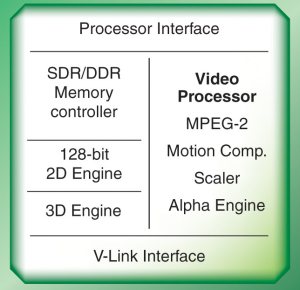What's under the hood ?

Presenting the all-new VIA C3 1GHz 'Nehemiah' CPU. If you kept a keen eye on our in-house EPIA M9000 review, you'll know that the CPU tasked with the processing duties was a 933MHz VIA C3 processor. This CPU appears to be just 67MHz faster than the predecessor ?. That's certainly true in pure MHz terms, but as AMD like to point out, MHz aren't everything. VIA have chosen the 1GHz milestone to replace the core architecture of the previous iteration of C3 CPUs. The EPIA M9000 featured the Ezra core. The M10000, in for review today, uses the new Nehemiah core. Just as Intel are fond of naming chipsets after U.S rivers, VIA seem to want to hark back towards religion with their naming shenanigans.
The Ezra C3 CPU was a stunted CPU, if we're being brutally honest. Running at up to 933MHz is one thing, but when the CPU's FPU (Floating Point Unit) is only designed to run at half the core's speed, you'll see why it wasn't a powerhouse of a processor. The new Nehemiah remedies this architectural blooper by providing full-speed FPU processing, that is, at the same speed as the core. We don't expect the Nehemiah to tackle today's high-end Pentium 4 and Athlon XP processors, simply because that's not its brief. What it really does need to do is keep a system ticking over nicely.
The Nehemiah is part of a package that's squarely aimed at the multimedia market. The original Ezra used AMD's defunct 3DNow optimisations. The Nehemiah does away with 3DNow and implements the more commonly used SSE instruction set popularised by Intel. Add to this a 16-stage pipeline that should help it scale well past 1GHz, an improved StepAhead Branch Prediction (read prefetching), 64kb of exclusive (not replicated from L1) L2 cache with 16-way associativity, and a 0.13u CPU that outputs a measly 11w. These attributes should give it the basic hardware beginnings of a reasonable CPU.
The Nehemiah core is designed by the same Centaur Group that handled the Ezra. They've also embedded a neat little feature into the Nehemiah that goes by the name of PadLock. Put simply, PadLock is a technology that allows the CPU to generate security keys based on a random number generator. The PadLock feature uses random electrical noise emitted by the CPU to generate these numbers and keys. As the CPU's noise is a highly unpredictable beast, the quality of the security offered will be impressive. Why do we need such security ?. The reasoning VIA put forward is based on the premise that the EPIA M10000 may well be used in a networking environment. Having secure data is of utmost importance to most people. Online transactions are one area that can benefit from such networking security, too.
We've established that the new core offers some reasonable advances over its predecessor. However, the EPIA system is more than just a CPU. VIA have pinpointed multimedia playback as a key use for their range of Mini-ITX boards. With that in mind, the Nehemiah 1GHz CPU is paired up with the CLE266 Northbridge and VT8235 Southbridge combination, shown below.

The purpose of the block diagram, kindly taken from VIA, is to show that the Northbridge does a little more than just be a gateway for the CPU. The CLE266 (Castle Rock) embeds a hardware MPEG-2 decoder, integrated graphics, and DDR support. A close-up of it is shown below.

MPEG-2 decoding and scaling is something that's absolutely necessary if the EPIA systems are to do well. The decoder helps offload the hard work from the CPU, leaving it free to perform other tasks. The second benefit, if you can call it that, is the inclusion of on-board graphics. The S3 integrated graphics share their bandwidth with the CPU, via the DDR memory controller. A 64-bit 3D engine doesn't bode well for performance, and the single rendering pipe and dual texture units won't have a Radeon 9800 quaking in its boots. That's not its aim though. It's their to provide a clean, crisp signal to a number of external video sources. We'll see how well it accomplishes this task a little later. The VIA VT8235 SB is often found on a number of VIA full-size motherboards. USB2.0, 10/100 LAN, and sound are provided natively. The EPIA, as you will see, makes good use of it.
Let's take a look at how the board integrates some of the features we've touched upon.









